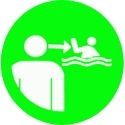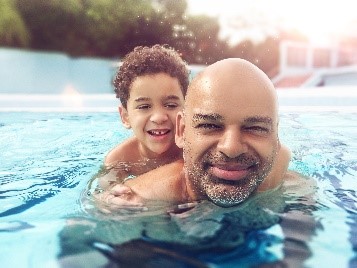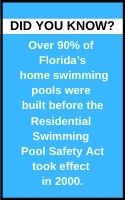|
|
|
of Protection |
|
Downloads |
|
|
Statutes and Codes |
The Layers of Protection
Keep water activities and swim time fun by incorporating multiple layers of water safety to protect you and others! Supervision, Barriers & Alarms, Be Prepared for Emergencies, Learn to Swim, Teach Children about Water Safety, and Wearing a Lifejacket will help keep children and adults safe while in or near water. Download the WaterSmartFL Facts handout and other materials on the resources page to learn more.
LAYER 1: SUPERVISION
|
|
Supervision, the first and most crucial layer of protection! This means a responsible person, usually an adult, is always actively watching when a child, or vulnerable person, is in, on or around the water. Keep distractions at bay. For most children ages 1–4, drowning occurs in a residential swimming pool. Children should be taught the dangers of pool drains and pipes and not to swim or play near them. |
Teach Children about Water Safety
|
When you teach children, and the whole family, about water safety, everyone can help be accountable for supervision. Knowing the rules of the pool, and how to safely help someone in trouble are just some of the ways to be water smart. There are many water safety programs available for free. To find one that fits your needs, check out the WaterSmartFL Partners by clicking on the logos on the Partners/Events tab. |
|
The "Water Watcher"
|
|
A Water Watcher is a responsible adult who is assigned the role of watching all the children and adults who are in or near the water. The Water Watcher’s focus, without distration, is always on the people in the water. This means: NO cell phones. NO books. NO earpods. NO conversations! If multiple adults are present, take turns acting as the Water Watcher. Have the Water Watcher wear a lanyard, so they don’t forget whose turn it is to watch the children. A Water Watcher tag is available for download on the Resources tab. |
LAYER 2: BARRIERS
|
|
A child should never be able to enter the pool area unaccompanied. Barriers (gates, fences, walls, doors, windows) physically block a child from accessing the pool. By putting alarms on windows and doors leading out of the house or to the pool/water will signal when a door or window is opened. High locks are another great option. Keep chairs and objects away from barriers so children do not climb them to gain access to the water. Always make sure all toys are removed from the pool so not to entice children. |
The Residential Swimming Pool Safety Act (Chapter 515, Florida Statutes) requires one of the following pool safety measures for pools built after October 1, 2000:
The Florida Department of Health recommends that all pools, at a minimum, use a combination of the barriers described above to help ensure safety around your pool/water. For barriers to work, they must be in good working order, on, and/or locked. Use this Fence Checklist to see if your barrier is good to go. |
|
LAYER 3: PREPAREDNESS
Know CPR
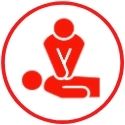 |
In an emergency, it is critical to have a phone nearby to immediately call 911. Know your location, what type of emergency and what help is being administered. It is also important to learn CPR with breaths and First Aid. Check with the American Heart Association, American Red Cross and/or the American Safety and Health Institute for more information on lifesaving classes. |
Learn to Swim
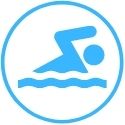 |
Everyone should know the basics of swimming, including floating, treading and moving through the water. Formal swim lessons can reduce the risk of drowning by 88 percent. It’s never too late to learn to swim! Make it a family activity and learn together. Organizations that provide swim lessons can be found on the Partners/Events tab. |
Wear a Lifejacket
 |
Lifejackets save lives. When enjoying open bodies of water such as lakes, springs, rivers or oceans, you should have a safety plan and equipment before going. When boating, children and adults should wear a properly fitted Coast Guard approved lifejacket, even if they know how to swim. Weak and non-swimmers should wear lifejackets when around and/or swimming in all bodies of water. Lifejackets DO NOT replace the need for supervision! |

